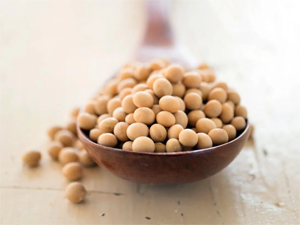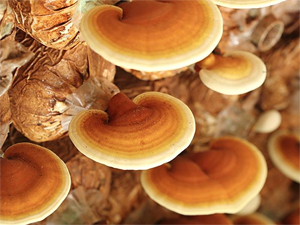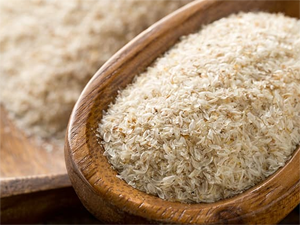Soybeans have been part of the human diet for around 5,000 years. Not only is soy cholesterol free, but it also has all the nutrients essential for good health: protein, essential amino acids, carbohydrates, and vitamins. It is high in fiber, low in saturated fat, and rich in minerals like calcium, iron, and phosphorus. It is also packed with disease-fighting nutrients like phytochemicals, antioxidants, and polysaccharides. Soy has been called the “yellow jewel” since ancient times due to its unique characteristics.
One of the Most Abundant Sources of Plant Protein
Soy is rich in protein, unlike many plant foods. Made up of 36%-56% protein, soy is one of the most abundant plant sources of dietary protein. Like animal protein, soy protein is complete in that it provides all the essential amino acids needed for human health.
Studies indicate that excess undigested protein may cause allergies. In addition, diets high in animal protein cause excretion of calcium through urine and heighten the risk of osteoporosis. Therefore, soy protein is an ideal source of protein in one’s daily diet.
Soy protein has a complete range of amino acids, especially lysine, which is lacking in most grains. Hence, soy is an ideal choice of protein for health-conscious people, vegetarians, and those managing their weight with low-calorie diets.
Excellent Source of Phytoestrogens
Soy contains natural phytoestrogens, mainly isoflavones and lignans. Their estrogenic effects are obvious when these natural phytoestrogens are concentrated together. Isoflavones are very important to good health. To date, soy is the most important and best-known source of isoflavones.
Some people believe that the phytoestrogen found in soy may cause hormone-related cancers, such as breast cancer, endometrial cancer, and prostate cancer. In actuality, phytoestrogens help to prevent cancer.
Soy isoflavones exert both estrogenic and anti-estrogenic effects. One theory is that phytoestrogens may act as anti-estrogens in premenopausal women who tend to have higher hormone levels. Phytoestrogens may block some effects of estrogen and thus protect against hormone- related cancers.
Phytoestrogens fill estrogen receptor sites on cells, keeping cancer- causing estrogen from promoting the growth of malignant cells. Therefore, phytoestrogens from plant foods may lower the risk of estrogen-dependent cancers, such as breast cancer.
According to a study by the National University of Singapore, the University of Southern California, and the University of Minnesota, Singapore Chinese women who regularly consumed soy products such as soy milk had a significant 18% reduction in breast cancer risk. This study tracked about 35,000 Chinese women over 10 years and was published in the British Journal of Cancer in 2008.
In another study, published in the International Journal of Cancer in October 2008, Japanese researchers found that high levels of soy food consumption appeared to specifically reduce the risk of estrogen receptor (ER)-positive tumors and human epidermal growth factor receptor 2 (HER2)-negative tumors.
Easily Absorbed Source of Calcium and Iron
Iron and calcium are minerals the body needs to keep bones healthy and to produce hemoglobin in the blood. Hemoglobin plays a key role in transporting oxygen in the body Soy, like all legumes, is a good source of calcium and iron. Just 100 g of boiled soybeans contain 145 mg of calcium and 2.5 mg of iron that are easily absorbed by the body. In addition, soy contains ferritin, a protein that stores iron and releases it in a controlled fashion. U.S. researchers studied 18 women, most of whom had marginal iron deficiency. They were given soybean soup and muffins made with soy flour. After 28 days, the researchers found there was a 27% increase of iron absorption in the women’s red blood cells.
Moreover, soy contains fructooligosaccharides (FOS), which can increase the amounts of good bacteria in the intestines. Research has also shown that FOS can increase the multiplication of Bifidobacterium bifidum (B. bifidum), which helps promote the absorption of calcium and magnesium and further reduces the risk of osteoporosis.
Immunity-enhancing Effects
In a study published in Tumori, rats were given the carcinogens dibutylamine and sodium nitrite, which resulted in depressed cellular and humoral immunity. Soybean was then administered. Results indicated an absence of tumor growth, demonstrating that soybean has the ability to increase immune function by enhancing both cellular and humoral immunity.
Strong Anticancer Effects
Phytates (the salts of phytic acid) in soy have been associated with reduced colon cancer risk. Research shows that soy saponins help to inhibit cancer cell growth. Furthermore, the main isoflavones in soy-genistein, daidzein, and glycitein – have anticancer effects. Isoflavones also work as antioxidants, destroying free radicals before they cause cells to mutate into cancer.
Genistein
Genistein has shown promise in preventing and treating prostate and breast cancers. Research shows that genistein can effectively inhibit the growth and spread of cancer cells. As such, the U.S. National Cancer Institute is studying the possibility of using genistein as an anticancer drug.
A large study spanning 10 years suggests that women with high blood levels of genistein seem to have lower risk of developing breast cancer. Among more than 24,000 middle-aged and older Japanese women, those with the highest blood levels of genistein were about 65% less likely to develop breast cancer compared to those with the lowest blood levels of genistein. This study is unique because the researchers measured blood levels of genistein instead of asking what the women ate. The researchers theorize that genistein may lower breast cancer risk by sitting in the estrogen receptors on breast cells and blocking the cancer-promoting effects of estrogen made by the body.
Daidzein
Daidzein may prevent hormone-sensitive cancers like breast cancer, endometrial cancer, and prostate cancer. It could be especially useful when used in tandem with other preventives and treatments. For instance, tamoxifen is an effective chemopreventive agent against ER-positive breast cancer. However, long-term use of tamoxifen may significantly increase the risk of endometrial cancer, which begins in the uterus. An experimental model by the University of Cyprus suggests that daidzein may lower the increased risk of endometrial cancer produced by tamoxifen.
Glycitein
Glycitein accounts for 5%-10% of the isoflavones in soy foods. Studies found it to have weak estrogenic activity. It may also have antioxidant activities and help prevent cancer, osteoporosis, and the formation of plaque inside the arteries.
Cardiovascular Disease Prevention
soy contains no cholesterol. Soy isoflavones have weak estrogenic effects that help lower low-density lipoprotein (“bad”) cholesterol and increase high-density lipoprotein (” good” cholesterol, thereby promoting heart health. Soy saponins help lower cholesterol by increasing bile excretion.
The U.S. Food and Drug Administration (FDA) has concluded that 25 of soy protein a day, as part of a diet low in saturated fat and cholesterol, may help to lower blood cholesterol levels, thereby lowering the risk of heart disease.
Research shows that an unhealthy diet high in sodium and low in potassium may lead to high blood pressure and atherosclerosis, both of which are main risk factors of stroke. Soy is rich in potassium, which helps the body to get rid of excess sodium, thus lowering the risk of stroke. Other research indicates that unsaturated fatty acids found in soybeans may help to lower cholesterol levels, prevent atherosclerosis, and decrease the accumulation of fats on arterial walls, thus helping to reduce the risk of stroke.
The high amounts of phytosterols in soy have the ability to lower cholesterol. Sitosterol makes up the largest proportion of phytosterols in soy (60%), followed by campesterol (20%) and stigmasterol (20%). Sitosterol has been used to treat hypercholesterolemia (very high levels of cholesterol in the blood). In addition, clinical studies have shown that phytosterol intake can reduce total cholesterol by 10% and LDL cholesterol by 15%.
Phytosterols can lower the body’s absorption of cholesterol. Research shows that consuming 1.5-1.8 g of phytosterols a day can reduce cholesterol absorption by 30%-40%, while an intake of 2.2 of phytosterols per day can reduce cholesterol absorption by 60%, thereby lowering the risk of cardiovascular disease.
Diabetes Prevention
The glycemic index of soybean is 10-23 which is very low. It will cause only small fluctuations in blood glucose and insulin levels, helping to keep the blood sugar levels more stable. The glycemic index indicates the ability of carbohydrate-containing foods to raise blood glucose levels within two hours, on a scale of 0-100.
Diabetics are two to four times more likely to develop cardiovascular disease than people without diabetes The American Diabetes Association recommends soy protein for diabetics. Research conducted in the UK showed how soy protein and soy isoflavones can aid in controlling blood sugar, helping postmenopausal women with type 2 diabetes become more sensitive to insulin, and reducing the risk of diabetes-related complications, such as heart disease and kidney damage.
In addition, soy is a good source of soluble fiber. Soluble fiber may help improve blood sugar control because it slows down the rate at which the body absorbs sugar.
Kidney Disease Prevention
Soy protein will not overburden the kidneys, hence reducing the risk of kidney damage. Studies have shown that soy protein is significantly better at aiding kidney function than animal protein.
Those with kidney disease must restrict their phosphorus intake. A result of damaged kidneys is hyperphosphatemia, or high level of phosphate in the blood. This interferes with calcium balance in the body. Although soybeans contain large amounts of phosphorus, it is in the form of phytate, which is poorly absorbed.
Osteoporosis Prevention
Middle-aged and elderly women are at higher risk of osteoporosis due to declining estrogen levels. One main condition experienced by menopausal women in the U.S. is hip fracture caused by osteoporosis. The rate of hip fractures caused by osteoporosis in menopausal American women is nearly double that of Japanese women. Research has shown that this may be due to the latter’s regular consumption of soy foods.
Scientists discovered that soy isoflavones can help increase the absorption of calcium in the intestines, promote bone renewal in the lumbar spine, and minimize bone loss while enhancing bone cell growth. This, in turn, enhances the body’s calcium absorption and increases bone density, helping to prevent osteoporosis and maintain bone health.
Weight Management
People seeking to manage their weight will usually follow a low-calorie diet. Adequate protein intake is very important when on a low- calorie diet because it helps prevent muscle loss. Muscle burns more calories than fat does. The more muscle a person has in relation to fat, the higher his or her metabolic rate will be. When on a low-calorie diet, not eating enough to build or maintain muscles will result in less muscle available to continue to burn calories. High in plant protein, soy is undoubtedly the ideal source of protein for people managing their weight.
Polypeptides and other compounds of soy also help weight loss in other ways. Scientists think that an active polypeptide in soy helps speed up the fat decomposition process. Experimental studies have shown that soy may aid weight loss by boosting metabolism. At the same time, soy peptides may interact with receptors in the brain to signal a feeling of satiety while delaying emptying of the stomach.
Moreover, the dietary fiber in soybeans allows one to feel full longer, which reduces the intake of other foods Soy is also low in calories and fat.
Hormone Balance
Isoflavones and other phytoestrogens in soy can mimic the effects of the female hormone estrogen and help to prevent the body’s estrogen level from being too high or low, keeping it at a normal level.
Because of this effect, soy helps to improve complexion, alleviate menstrual discomfort, delay the onset of menopause and visible signs of aging, and may prevent diseases caused by hormonal imbalances, like breast, endometrial, and prostate cancers. For postmenopausal women, phytoestrogen in soy act like estrogens, thus relieving symptoms of menopause, such as hot flashes and increases in body temperature.
Brain Activity Enhancement
Phospholipids are crucial to brain health. Soy is rich in phospholipids, specifically lecithin, hence a diet high in soy contributes to better learning capabilities and helps to improve memory and vitality.
Blood Clot Prevention
Research has found that the soyasaponin in soy helps control blood platelets from lessening and thrombin, a key clot promoter, from forming, effectively preventing blood clots.
Complexion Improvement
Research shows that soybean paste contains linoleic acid, which helps suppress the formation of excess melanin, which is the main cause of pigmentation. At the same time, it helps promote softer, smoother, and fairer skin.
Did You Know? Soy Myths
Recently, there were concerns that soy might burden health because it contains phytic acid and purine. These are unfounded, as many studies have proven that soy consumption is safe and beneficial to health.
Soy and phytic acid
Soy contains moderate amounts of phytic acid, a natural organic acid present in the hulls of grains and seeds. Its unique structure enables it to bind easily to elements like calcium, iron, magnesium, phosphorus, and, in particular, zinc in the gastrointestinal tract. Hence, some people think that long-term consumption of soy products will cause a deficiency of trace elements in the human body and suggest that those with zinc deficiency avoid soy products such as soy milk.
In actuality, soy is rich in iron and calcium that are easily absorbed by the human body. It is also rich in FOS, which can promote absorption of calcium and magnesium, thereby making up for the metallic elements bound to phytic acid. In addition, fermented soy (such as preserved bean curd, preserved soybeans, and natto) can also alleviate the phytic acid problem. During fermentation, microorganisms break down the phytic acid in soy so that minerals present in soy like calcium, iron, and zinc can be more easily absorbed by the human body.
Hence, phytic acid in soy will not have a major effect on mineral absorption when individuals consume moderate suitable amounts of soy products as part of a balanced diet. In fact, phytic acid benefits health with its anticancer effects. To reduce the amount of phytic acid, soak soybeans before removing their skin.
Soy and purine
Gout commonly affects men over 40 years old and menopausal women. It is a disorder of purine metabolism. Purine is an organic compound that occurs naturally in the human body. It is the main component of DNA and RNA and is essential for providing energy, regulating metabolism, and forming coenzymes.
Aging body cells or excessive consumption of purine-rich foods such as organ meats and seafood can lead to excessive amounts of purine in the body. Uric acid is produced when the body breaks down purines. If the body cannot remove excess uric acid in time or the uric acid excretion mechanism degenerates, there will be high levels of uric acid in the blood. This can cause painful uric acid crystals to form in joints, tissues, and kidneys, causing the immune system to mount an attack against these crystals because they do not belong there. This immune reaction causes inflammation and induces gout.
A myth is circulating that gout patients should avoid soybeans and soy products, especially soy milk, because they are rich in purine, which is highly hydrophilic and increases greatly after soybeans are ground into soy milk. That is not true. The amount of purine in soy is moderate; it is lower than purine-rich foods (e.g., organ meats) but higher than foods low in purine (e.g., fruits and vegetables).
Most purines are removed along with excess water during the manufacturing process of many soy products. Five hundred grams of soybeans can produce 2,500 ml of soy milk. Hence the amounts of purines in 500 ml of soy milk is insignificant. A study by Japanese researchers concluded that tofu is a safe source of protein for gout patients due to its small and transient effect on plasma urate levels. A 12-year study involving more than 45,000 men found that higher levels of meat and seafood consumption are associated with an increased risk of gout, whereas moderate intake of purine–rich vegetables is not associated with an increased risk of gout.
In addition, estrogens help inhibit the formation of uric acid. Soy isoflavones can restore balance to men experiencing irregularities in uric acid elimination due to interference from male hormones and replenish estrogens in menopausal women, thereby reducing gout incidence. Compared to fish, meat, seafood, and freshwater delicacies, soy and soy products are relatively safer and more ideal sources of protein.




